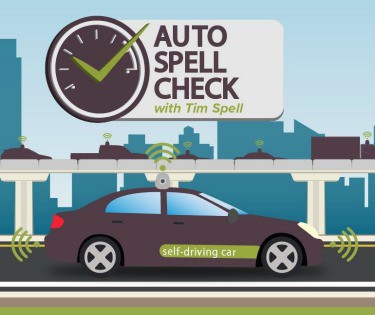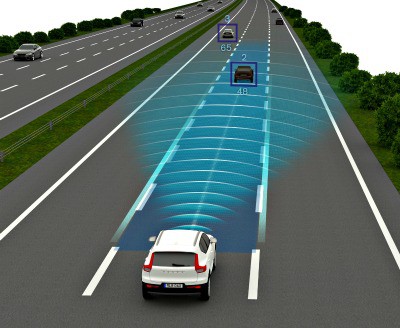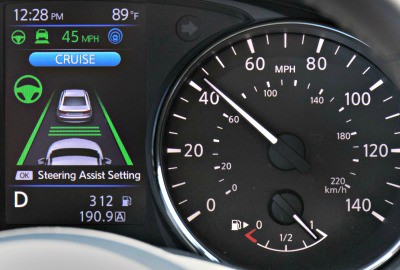What Driverless Auto Features Are Available Today?

Editor’s Note: This insuranceQuotes article is one in a series exploring the future of self-driving automobiles and how they will reshape society and Americans’ attitudes toward commuting, road-tripping and even that quick trip to the market.
Despite all the talk about driverless cars and videos on the web showing them in action, a total-driverless experience isn’t available to real-world auto consumers just yet.
So what’s a tech-hungry driver to do right now? Well, a few semiautonomous vehicles are in mass production that come close to providing that driverless experience.
These smart vehicles do much more than just get consumers’ feet wet in the fast-moving wave of autonomous technology. Cadillac’s Super Cruise, Volvo’s Pilot Assist II and Nissan’s ProPILOT Assist are among a growing list of auto-manufacturer systems that are taking owners to the edge of 100-percent-driverless convenience.
Cadillac is pushing technological limits on its CT6 “prestige sedan,” Volvo bests its original system with a more-sophisticated second-generation version across the lineup, and Nissan recently introduced its affordable system on Rogue CUV and Leaf all-electric models.
 The main difference among these semiautonomous Level 2 systems and full-blown Level 5 driverless technology is that the driver must be alert in case evasive action is necessary.
The main difference among these semiautonomous Level 2 systems and full-blown Level 5 driverless technology is that the driver must be alert in case evasive action is necessary.
Semiautonomous vehicles require clear road markings on either side of the car, and will follow the road with steering, control the distance from the car ahead, regulate speed and apply brakes.
Operation of Volvo and Nissan systems requires a hand on the steering wheel to indicate a driver is ready to take control, but Cadillac’s Super Cruise is an exception. The manufacturer bills its CT6 system as the “first true hands-free driving technology for the highway.”
Cadillac lists the benefits of hands-free steering as both a convenience feature and driver’s aid in safely conducting tasks such as talking on a cell phone, operating the navigation system or adjusting audio controls.
Automakers want to ‘keep drivers engaged’
Even though its CT6 sedan can navigate highways without a driver’s hand on the steering wheel, Cadillac believes its “important to keep the driver engaged during the operation,” says Barry Walkup, chief engineer of Cadillac Super Cruise.

“That’s why we’ve added a driver-attention function, to insist on driver supervision.”
Cadillac’s approach to ensuring driver focus is via a small camera directed at the driver’s head. Utilizing infrared lights, the camera tracks head position to determine where the driver’s looking. If the driver looks away from the road too long, alert prompts are issued. If unresponsiveness is detected, the system can bring the car to a controlled stop and contact OnStar to summon first responders.
While a hand on the steering wheel is a must for Volvo’s Pilot Assist II operation, the automaker boasts its system also provides near-self-driving capability.
According to the owner of an S90 with Pilot Assist II, “he drove completely across the state of Ohio and never did anything to tell the car what to do. The car drove itself across Ohio,” says Russell Datz, Volvo Car U.S.A. national media relations manager.
Volvo and Nissan provide similar explanations about the benefits of the pilot-assist systems.
“The car frees your mind up to do other things,” says Datz. William Mattiace, manager, Nissan Communications. “It really relieves stress, relieves fatigue and makes the driving experience a lot better.”
There’s a learning curve in adjusting to the ProPILOT system, Mattiace says.
“Once they know what the system does and understand it, they love it and they leave it on – especially if you live in places like LA. It’s sort of driving is believing,” he says. “It does really well in heavy traffic and on long open drives.”
Driver sharing system is like ‘riding a horse’
Volvo’s Pilot Assist II also is intended for the more-mundane parts of driving such as stop-and-go traffic or long stretches of open highway, Datz says.
“Interstate driving is really where it shines. It’s not the kind of system that you push a button and it navigates the twisties for you. That’s for you to enjoy.”
Pilot Assist II is viewed by Volvo as a safety system, in which the driver shares control with the vehicle.

“You could compare it with riding a horse,” says Erik Coelingh, Volvo senior technical leader, active safety. “You are in control of the horse. You can decide where to go, but the horse will not jump off the cliff and it will not collide into anything.”
While the execution of semiautonomous systems varies with manufacturers, Volvo and Nissan setups basically involve a camera behind the windscreen to read lane markers.
Radar sensors are strategically positioned around the vehicle to detect possible sources for collision. This includes front sensors to judge the distance of vehicles ahead to help maintain proper following distance. A hand on the steering wheel is detected by a sensor that measures opposite steering torque.
Cadillac’s Super Cruise stands apart as the first system to use precision lidar map data to provide detailed information about the road ahead.
Datz describes Volvo’s smart cars as being “essentially self-aware.” Understanding the advanced stage of development of the new semiautonomous vehicles awakes the senses with the realization that the availability of 100-percent-self-driving vehicles is nearing reality.

